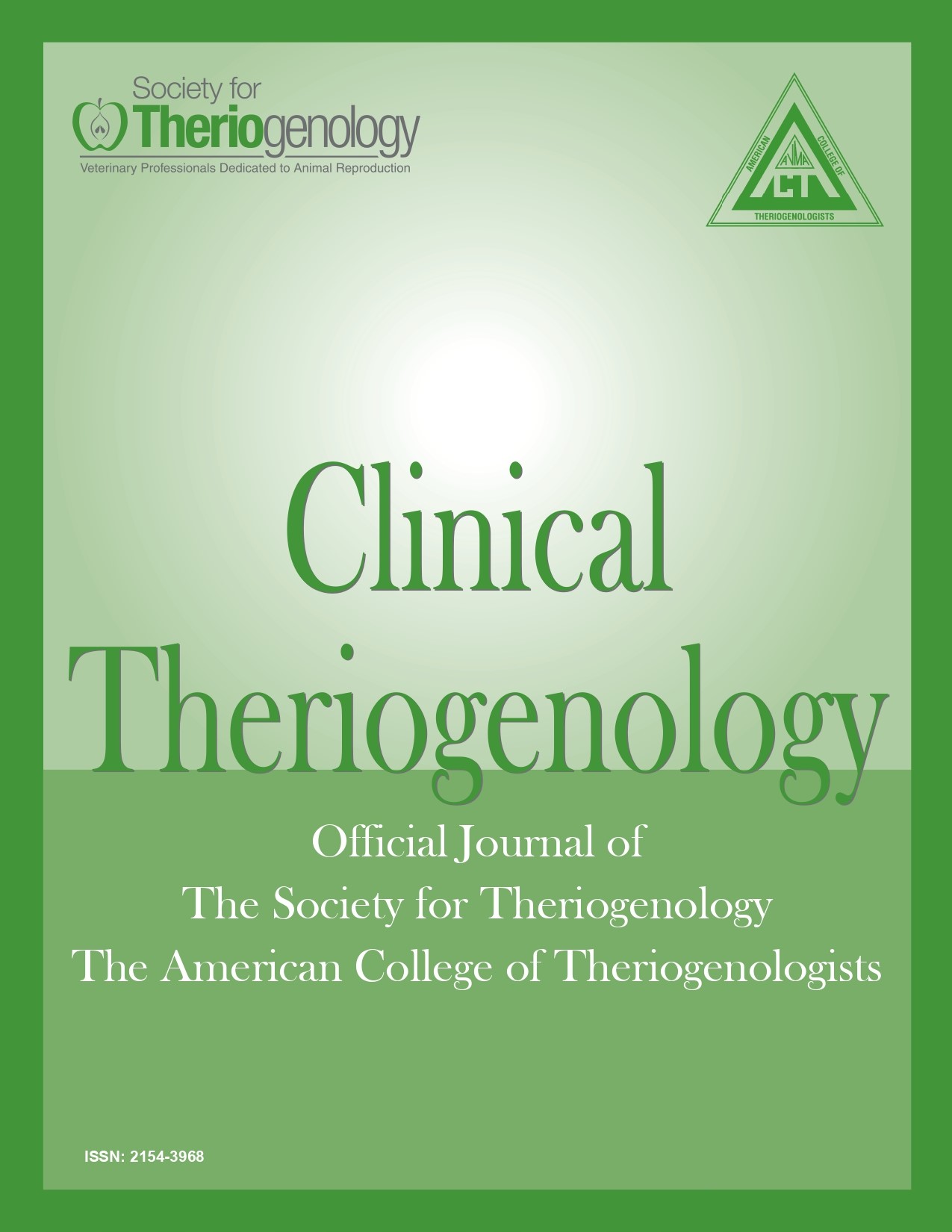Diaphragmatic hernia involving gravid uterus in a dog
Abstract
A 4-year German Shorthair Pointer pregnant dog was presented for severe tachypnea and depression. She had 1 natural breeding 52 days ago. Diaphragmatic hernia with intrathoracic displacement of the uterus was diagnosed via radiography and ultrasonography. Emergency herniorrhaphy was elected and the owner requested to save the litter if possible. Right uterine horn tip, spleen, part of liver, pancreas, and part of greater omentum were in the thorax. Intraoperative transuterine ultrasonography confirmed live fetuses and pregnancy was permitted to continue. Patient received supportive medical care for 3 days. Based on ultrasonography findings (eminent danger to litter), decision was made to perform an emergency cesarean surgery (56 days after breeding). Six of 11 pups were alive and 1 mummified fetus had an elongated neck (perhaps due to entrapment in the diaphragmatic hernia).
Downloads
References
2. Gibson TWG, Brisson BA, Sears W: Perioperative survival rates after surgery for diaphragmatic hernia in dogs and cats: 92 cases (1990–2002). J Am Vet Med Assoc 2005;227:105–109. doi: 10.2460/javma.2005.227.105
3. Worth AJ, Machon RG: Traumatic diaphragmatic herniation: pathophysiology and management. Compend Contin Educ Pract Vet 2005;12:178–191.
4. Wilson GP, Newton CD, Burt JK: A review of 116 diaphragmatic hernias in dogs and cats. J Am Vet Med Assoc 1971;159:1142–1145.
5. Minihan AC, Berg J, Evans KL: Chronic diaphragmatic hernia in 34 dogs and 16 cats. J Am Anim Hosp Assoc 2004;40:51–63. doi: 10.2460/javma.2005.227.105
6. Schmiedt CW, Tobias KM, Stevenson MAM: Traumatic diaphragmatic hernia in cats: 34 cases (1991–2001). J Am Vet Med Assoc 2003;222:1237–1240. doi: 10.2460/javma.2003.222.1237
7. Hyun C: Radiographic diagnosis of diaphragmatic hernia: review of 60 cases in dogs and cats. J Vet Sci 2004;5:157–162. doi: 10.4142/jvs.2004.5.2.157
8. Williams J, Leveille R, Myer CW: Imaging modalities used to confirm diaphragmatic hernia in small animals. Compend Contin Educ Pract Vet 1998;20:1199–1210.
9. Hamilton T: Traumatic and incisional hernias. In: Aronson LR, editor. Small animal surgical emergencies. 2nd edition. Wiley Online Library; Hoboken, New Jersey, 2022. p. 190–198.
10. Verstegen-Onclin K, Verstegen J: Endocrinology of pregnancy in the dog: a review. Theriogenology 2008;70:291–299. doi: 10.1016/j.theriogenology.2008.04.038
11. Moore J, Bill KM, Flynn RJ, et al: A comparison between propofol and thiopentone as induction agents in obstetric anaesthesia. Anaesthesia 1989;44:753–757. doi: 10.1111/j.1365-2044.1989.tb09263.x
12. Siafaka I, Vadalouca A, Gatziou B, et al: A comparative study of propofol and thiopental as induction agents for elective caesarean section. Clin Exp Obstet Gynecol 1992;19:93–96.
13. Valtonen M, Kanto J, Rosenberg P: Comparison of propofol and thiopentone for induction of anaesthesia for elective caesarean section. Anaesthesia 1989;44:758–762. doi: 10.1111/j.1365-2044.1989.tb09264.x
14. Luna SPL, Cassu RN, Castro GB, et al: Effects of four anaesthetic protocols on the neurological and cardiorespiratory variables of puppies born by caesarean section. Vet Rec 2004;154:387–389. doi: 10.1136/vr.154.13.387
15. Moon-Massat PF, Erb HN: Perioperative factors associated with puppy vigor after delivery by cesarean section. J Am Anim Hosp Assoc 2002;38:90–96. doi: 10.5326/0380090
16. Moon PF, Erb HN, Ludders JW, et al: Perioperative risk factors for puppies delivered by cesarean section in the United States and Canada. J Am Anim Hosp Assoc 2000;36:359–368. doi: 10.5326/15473317-36-4-359
17. Mathews KA, Dyson DH: Analgesia and chemical restraint for the emergent patient. Vet Clin North Am Small Anim Pract 2005;35:481–515. doi: 10.1016/j.cvsm.2004.10.012
18. Concannon P, Whaley S, Lein D, et al: Canine gestation length: variation related to time of mating and fertile life of sperm. Am J Vet Res 1983;44:1819–1821.
19. Rendano VT Jr., Lein DH, Concannon PW: Radiographic evaluation of prenatal Development in the Beagle. Vet Radiol 1984;25:132–141. doi: 10.1111/j.1740-8261.1984.tb01924.x
20. Shille VM, Gontarek J: The use of ultrasonography for pregnancy diagnosis in the bitch. J Am Vet Med Assoc 1985;187:1021–1025.
21. Kgm DC, Jo N. Towards scheduled pre-parturient caesarean sections in bitches. Reprod Domest Anim Zuchthyg 2020;55:38–48. doi: 10.1111/rda.13669
22. Toal RL, Walker MA, Henry GA: A comparison of real-time ultrasound, palpation and radiography in pregnancy detection and litter size determination in the bitch. Vet Radiol 1986;27:102–108. doi: 10.1111/j.1740-8261.1986.tb00013.x
23. Kutzler MA, Yeager AE, Mohammed HO, et al: Accuracy of canine parturition date prediction using fetal measurements obtained by ultrasonography. Theriogenology 2003;60:1309–1317. doi: 10.1016/S0093-691X(03)00146-8
24. Beccaglia M, Luvoni GC: Comparison of the accuracy of two ultrasonographic measurements in predicting the parturition date in the bitch. J Small Anim Pract 2006;47:670–673. doi: 10.1111/j.1748-5827.2006.00108.x
25. Lopate C: Estimation of gestational age and assessment of canine fetal maturation using radiology and ultrasonography: a review. Theriogenology 2008;70:397–402. doi: 10.1016/j.theriogenology.2008.05.034
26. Nyland TG, Mattoon JS: Small animal diagnostic ultrasound. Elsevier Health Sciences; New York, 2002.
27. Gil EMU, Garcia DAA, Giannico AT, et al: Canine fetal heart rate: do accelerations or decelerations predict the parturition day in bitches? Theriogenology 2014;82:933–941. doi: 10.1016/j.theriogenology.2014.04.025
28. Deschamps JY, Kolb H, Descol C, et al: Chronic diaphragmatic hernia with herniation of the gravid uterus in a female dog – a case report and a review. Rev Med Veterinaire 2012;163:299–301.
29. Sullivan JL, Puckett JR, Sevedge JP: Ruptured diaphragm with herniation of the gravid uterus and abdominal viscera. J Am Vet Med Assoc 1969;155:941–942.
30. Bellenger CR, Milstein M, McDonell W: Herniation of gravid uterus into the thorax of a dog. Mod Vet Pract 1975;56: 553–555.
31. Iwasaki M, Sterman FDA, Fonseca AC: What is your diagnosis? Peritoneopericardial diaphragmatic hernia with herniation of mineralized fetuses. J Am Vet Med Assoc 1999;214:1775–1776.
32. Merbl Y, Kelmer E, Shipov A, et al: Resolution of persistent pneumothorax by use of blood pleurodesis in a dog after surgical correction of a diaphragmatic hernia. J Am Vet Med Assoc 2010;237:299–303. doi: 10.2460/javma.237.3.299

This work is licensed under a Creative Commons Attribution-NonCommercial 4.0 International License.
Authors retain copyright of their work, with first publication rights granted to Clinical Theriogenology. Read more about copyright and licensing here.







